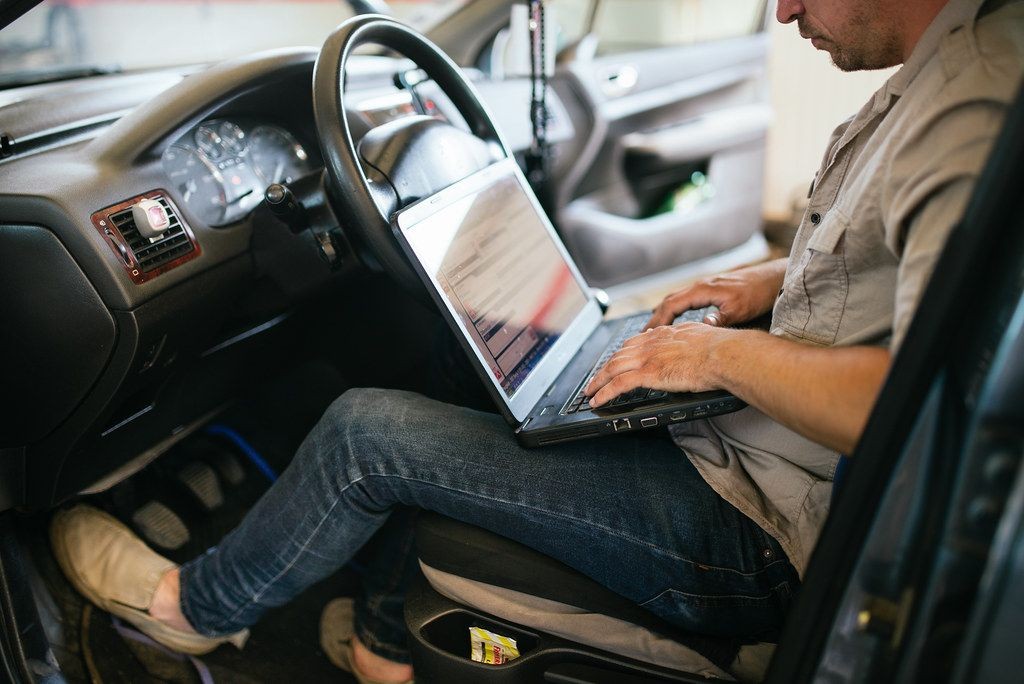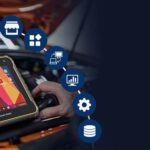Modern vehicles contain about ten times more control units than the average car from the 1990s. This allows for the diagnosis of a much wider range of issues simply by reading error codes. This is where On-Board Diagnostics (OBD2) scanners come into play.
Learning how to use an OBD2 scanner can save you significant time and money. Here’s everything the average driver needs to know about them.
Alt text: A mechanic using an OBD2 scanner connected to a car’s diagnostic port to perform vehicle diagnostics.
What Does an OBD2 Scanner Do?
An OBD2 scanner is a powerful tool that connects to a special port in your car to gather data from its control units. This includes diagnostic trouble codes (DTCs) and live data – readings of pressure, temperature, and speed, among other parameters.
This data originates from various sensors throughout your vehicle. Typically, error codes appear when sensor readings are out of the normal range or if a sensor is unresponsive.
More advanced diagnostic tools can also perform service functions and even coding, which is necessary when replacing certain components in modern vehicles.
On-board diagnostics have been mandatory for all cars manufactured since 1996 in the USA and since 2004 in Europe.
Types of OBD2 Scanners
Today, the market offers a wide variety of OBD2 scanners. The simplest and most affordable option is a Bluetooth OBD2 code reader that connects to your smartphone. These often cost very little and can read error codes and basic live data, making them convenient for the average driver.
For DIY enthusiasts who prefer to handle car repairs themselves, investing in a more advanced OBD2 scanner is beneficial. These enhanced scanners can reset service reminders, activate service functions like brake pad replacement mode, and read a broader range of live data. Their price starts from around $100 and varies depending on features.
Standard OBD2 scanners may not always suffice for professional mechanics who need to be prepared for everything from an oil change to an engine replacement. Reading error codes and live data is just the tip of the iceberg compared to the coding and programming capabilities found in professional OBD2 diagnostic tools.
With the right equipment, a professional auto electrician can customize virtually any option in a modern car. However, these professional tools can cost thousands of dollars and are too complex for the average user.
How to Read OBD2 Error Codes
Reading error codes is the most crucial aspect of OBD2 diagnostics. Therefore, if you intend to use an OBD2 scanner, this is the first skill to learn.
The controls on diagnostic tools vary by model, but the basic operation is generally consistent.
1. Connect the Scanner
All modern cars have an OBD2 port, usually located under the steering wheel or somewhere on the center console. This port is often covered by a small plastic flap. Locate it and plug in your OBD2 scanner.
Alt text: Illustration showing a highlighted OBD2 port location under the steering wheel of a car, indicating where to connect a diagnostic scanner.
Many modern scanners and code readers use Bluetooth instead of wires – ensure Bluetooth is enabled if applicable.
2. Turn on the Ignition
Car computer diagnostics are not possible without the ignition being turned on, so switch the ignition to the “ON” position before scanning. Turn off headlights, radio, and air conditioning to minimize electrical load.
Most vehicles allow error codes to be scanned with the engine running. Error codes are stored until cleared, and running the engine is useful when viewing live data for various readings.
3. Select Your Vehicle
Once the OBD2 scanner is connected and the ignition is on, you can select your car’s make, model, and trim. This information helps the tool recognize the control units and correctly interpret the readings.
Many modern diagnostic tools have an auto-detect system that automatically identifies the VIN code and fills in all the necessary details. Alternatively, you can manually enter the VIN code if the scanner does not automatically detect it.
4. Scan for Error Codes
Finally, select the option to read codes. Most scanners allow you to choose which modules to scan or offer a full scan of all available control units.
If you have trouble finding these options, consult the built-in help page or the user manual.
Depending on the car model, a full scan can take from a few seconds to several minutes.
5. Check the Discovered Error Codes
The error codes found after scanning are the primary reason for indicator lights on your dashboard. Sometimes codes are straightforward, like “00287 – ABS Wheel Speed Sensor; Rear Right”. This likely indicates that the rear right ABS sensor needs replacement.
However, the problems behind error codes can sometimes be more complex than they initially appear. For instance, “P0171 – System Too Lean (Bank 1)” indicates a lean fuel mixture, but this could be due to a clogged fuel filter, fuel pump issues, a vacuum leak, sensor problems, and more.
Expert Tip: Reading Live Data
Reading live data is an excellent supplement to troubleshooting. Most control units have an additional section for live data, allowing you to monitor parameters in real-time. How is this helpful?
Suppose your car lacks power, and the only error code is “vehicle in restricted mode.” You can check fuel and boost pressure, intake airflow, and intake manifold pressure in live data to pinpoint potential issues.
Alt text: Close-up of an OBD2 scanner screen displaying live data readings during a car diagnostic session.
However, even with access to all these features, you might still need help interpreting error codes and diagnosing problems effectively.
An Essential Tool When Buying Used Cars
Today’s used car market is fraught with potential pitfalls for buyers. Sellers may exploit buyer trust, selling vehicles with hidden histories, electrical issues, and legal problems.
While vehicle history reports can provide valuable insights into a car’s past, a proper pre-purchase inspection is crucial to avoid significant repair costs down the line.
Always obtain a history report and check for error codes before buying a used vehicle. If you don’t have an OBD2 scanner or are unsure how to use one, consider a professional car inspection.
How to Clear Error Codes
Scanning for codes is part of diagnosing car problems, but codes often don’t directly reveal the issue. Even if diagnostics point to a mass airflow sensor problem, auto electricians will use a multimeter to test the sensor to confirm the fault and avoid unnecessary parts replacement. You might be surprised how often such codes appear due to wiring issues, loose connections, and corrosion.
Once the problems are identified and fixed, they need to be rectified and the error codes checked again. If no codes reappear, the problem is likely solved, and you’re good to go.
FAQ
Alt text: Evaldas Zabitis, author of the article, a car enthusiast and expert in automotive technology.
By Evaldas Zabitis
Evaldas has been writing since school and has been passionate about cars his entire life. Right after getting his driver’s license, he spent all his savings on cheap cars to spend time repairing, driving, and selling them. Evaldas is always interested in technical innovations in the automotive field and actively participates in automotive community discussions.

